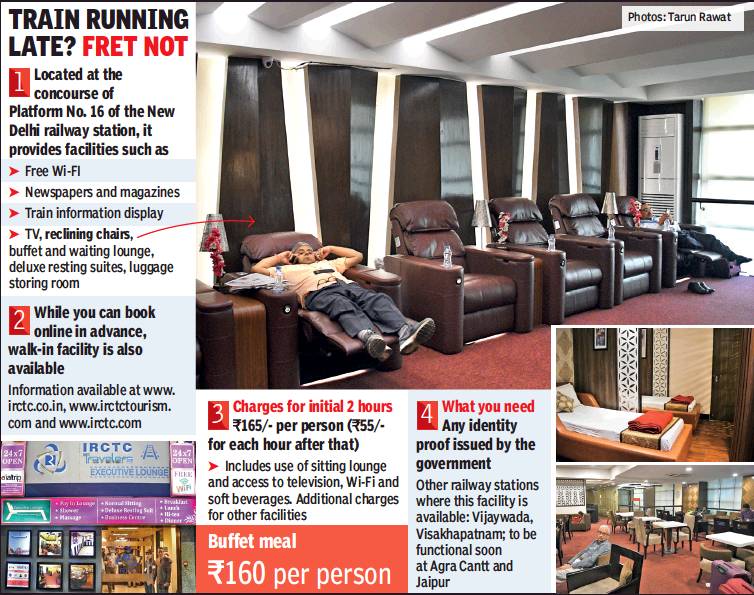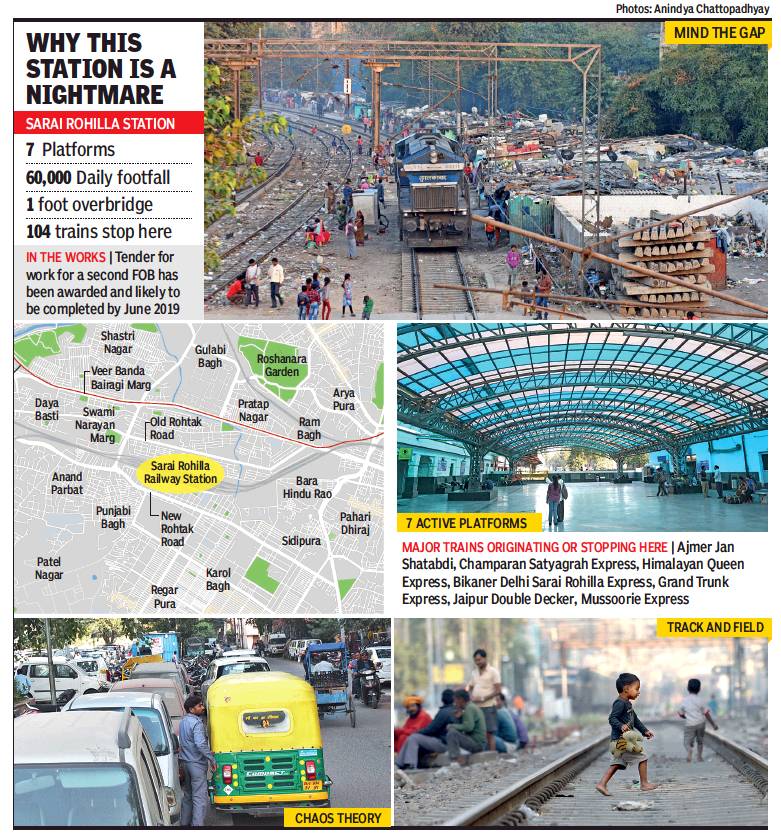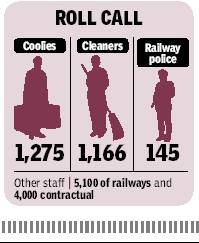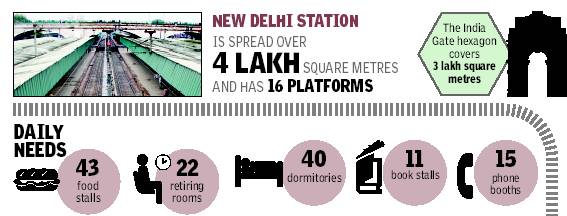Delhi/ New Delhi: Railway Stations
This is a collection of articles archived for the excellence of their content. Readers will be able to edit existing articles and post new articles directly |
Contents |
NEW DELHI RAILWAY STATION
Essential facts/ as in 2013
BETWEEN THE LINES
Nanya Srivastava | TNN
On any day, the city’s biggest railway station handles more than 300 trains and serves around 5 lakh people. It’s an exceedingly complex job that keeps nine departments and close to 9,000 staff on their toes. “Everything has a schedule and it has to be followed. It requires planning, anticipating what can go wrong, and making arrangements accordingly,” says BK Shukla, the chief station manager.
The power cabin handles three of the station’s most important functions—signalling, traffic and public address—and on this afternoon two men are coordinating the movement of trains over walkie-talkies. They have to update the wall map and ensure that the platforms are cleared for the coming trains on time. Although the station has 16 platforms, there are only four tracks leading in and out of it, and with a train every five minutes, on average, there’s a lot of coordination to be done. Especially in the rush hours, like on this hot afternoon.
Within the power cabin, a man sits in a small enclosure, making announcements on a microphone. Now he’s calling the attention of a woman whose husband is waiting at the entrance of platform 1. Another official sits at a computer that plays recorded announcements.
Besides the three important functions handled by the power cabin, the station has other departments—mechanical, electrical, engineering, commercial, telecommunication, security and medical—for smooth operation. However, the nerve centre is the cabin of the chief station manager. He coordinates with all the departments and takes care of any glitch that occurs.
The information will soon be available on the 139 helpline and announced on the public address system. The PA system and train information boards are maintained by the telecommunication department. Shukla says each department has a task and as long as they do their bit, there are no problems.
The traffic department sees to it that trains run on time, while the signals department handles 309 signals on the station to guide trains and also maintains tracks. The mechanical, electrical and engineering departments are responsible for technical maintenance of trains and ensure they are safe and the passenger amenities are in order. The train drivers are supervised by the mechanical department, which also takes care of the loco shed where the engines are kept.
The crucial passenger interaction is handled by the commercial department. It manages booking of tickets, train charts, ticket checking, waiting rooms, retiring rooms, catering and enquiry. The department also handles parcels (or luggage). A luggage van—every train has two—has a capacity of eight tonnes, but special trains like Rajdhanis have four-tonne vans.
The cups of tea sold in a day: 5,000.
The security arrangements: there are 152 CCTV cameras and the footage from all of them can be viewed. The security is managed by Railway Protection Force (RPF) and Government Railway Police (GRP). The medical department, apart from keeping first aid boxes at platforms 1 and 16, also employs staff to clean the station area.
There is no opening or closing time for the station. The enquiry sections are among the most crowded parts. The officials claim that the line “never breaks”. It thins in the night and thickens by afternoon but there is no time when there aren’t people at the counter. “In rush hour, we answer queries of 500-odd people in an hour,” says an official before turning his attention back on the crowd.
Amenities
Waiting lounge
Jasjeev Gandhiok, Luxury at rly station you may not know of, February 26, 2018: The Times of India

From: Jasjeev Gandhiok, Luxury at rly station you may not know of, February 26, 2018: The Times of India
Opened In 2012, Waiting Lounge At New Delhi Station Sees Just 150 Passengers A Day
Unknown to many — but complete with deluxe suites, reclining chairs and buffet meals — the New Delhi Railway Station houses a waiting lounge that is capable of giving any similar facility at leading airports a run for their money. Believe it or not, the lounge, on platform number 16, has been in existence for nearly six years now. Opened as a part of a pilot project to provide executive lounges on railway stations on the lines of airports, the facility surprisingly sees just 150 passengers a day.
The lounge is run by the Indian Railway Catering and Tourism Corporation (IRCTC).
While the executive lounge model has been recreated at Vijayawada and Visakhapatnam, and will soon be opened at Agra Cantt and Jaipur railway stations too, IRCTC officials admitted that few people knew about the facility at NDLS despite it being the first off the blocks.
“The average footfall is about 150 a day. This increases to around 350 passengers during the peak season. While a majority of travellers make their bookings online, we have a walk-in option too. Not many people appear to be aware of it,” a senior IRCTC official said.
For using the lounge for two hours, a passenger needs to pay Rs165. This provides them access to free Wi-Fi and reclining chairs, among other facilities. Passengers can also pay an additional amount to use deluxe suites — a viable option if a train is running late.
“Access to these lounges is controlled by a smart card, which can track how many hours you have been inside. People usually use the suites when they have a train to catch the same day,” the official said.
IRCTC officials said they planned to make renewed efforts to popularise its executive lounges with 15 more such facilities in the pipeline in 2018-19. “Our focus currently is on the golden triangle of Jaipur, Delhi and Agra, which, we hope, will catch the imagination of people. These stations witness the highest footfall among foreign passengers and tourists,” the IRCTC official said.
SARAI ROHILLA
Status, as in 2018

From: Jasjeev Gandhiokm Losing track of time: Over 60,000 brave odds at this station daily, December 10, 2018: The Times of India
SARAI ROHILLA: Squatters Make Train Travel Nothing To Look Forward To
Ensure you have time in hand if you have to board a train at Sarai Rohilla railway station. You are likely to get caught in the unmoving crowd on the narrow passage to the station that is perennially crammed with e-rickshaws and autos. A train journey to the station is no joy ride either, with passengers at risk as they approach the railway station because it slows down at Daya Basti, an illegal settlement a short distance away and a hub of criminals and snatchers.
“At night people avoid the portions of the railway station close to the illegal habitations,” admitted a railway official. “Passengers come under attack when the trains slow down. Antisocials enter the trains and snatch whatever they see before escaping to their unauthorised dwellings. They have even tried snatching my phone a couple of times.”
Despite these risks, people are forced to use the station. Sarai Rohilla caters to around 60,000 passengers each day and has seven active platforms. Every day, 104 trains halt there, among them the Ajmer Jan Shatabdi, Himalayan Queen, Jaipur Double Decker and Champaran Satyagrah Express.
But there is recognition of the adverse conditions at the station, and Northern Railways says a new access road is being planned. R N Singh, divisional railway manager, Delhi Division, Indian Railways, said, “Widening the existing access road is not possible because it is no municipal corporation land. So we plan to lay another road on the other side of the railway tracks. This could possibly become the main approach road later.”
However, the site chosen for the new road doesn’t look free of encumbrances. The residents of the illegal colonies utilise it as a play area. They regularly use the space to cross the tracks, resulting in a few accidents in the past. The railway staff claimed to have tried removing the encroachers from the area, but said each time they returned after a couple of days. “We have started ignoring them, but the danger is always there,” said a railway official manning the platform.
Singh said everyone recognises the problem, and the Railways will soon start fencing the locations in the station’s proximity to ensure proper land demarcation. “If we cannot remove these illegal colonies, we can at least fence the railway areas. If people intrude illegally, the railway police can take action,” said Singh.



